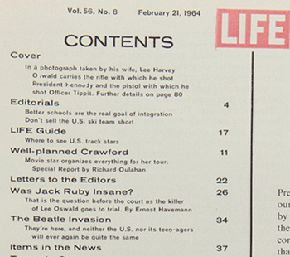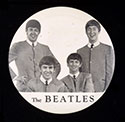| |
Introducing…the Beatles
On the surface, the Beatles seemed an unlikely music group to create such a sensation in America. After all, American rock ‘n’ roll singers had long been the recognized icons of popular music. The Beatles’ British hits had received little attention through most of 1963. Capitol Records, the Beatles’ U.S. recording outlet, had thought so little of their music that the company refused to produce their records and allowed lesser-known labels to pick them up. Even these records got little airplay on the radio.
Perhaps the outpouring of emotion during the Beatles’ first visit to America in February 1964 can be partially explained by the fact that the nation was still in mourning over a beloved President. Only weeks earlier—November 22, 1963—President John F. Kennedy had been assassinated and the aftermath of this tragic event was still making headlines. Young people took President Kennedy’s death particularly hard. With him seemed to go the optimism and the sense of possibility he had inspired. But then, mere weeks later, the Beatles appeared—bringing with them a new energy and excitement, an uncanny ability to flaunt authority, and an exuberance in their songs that rock ‘n’ roll music seemed to have lost in recent years. In her book, Where the Girls Are: Growing Up Female with the Mass Media, historian Susan Douglas described this link between President Kennedy and the Beatles:
It was to fill this emotional and spiritual void, this deep grieving over a beloved, charismatic, and witty young man, that we would react to a group of four different young men, also attractive, witty and a clear departure from the past….Through the Beatles, some of us began to believe again that things were going to be all right.
 |
In the February 21, 1964 issue of Life magazine, the Kennedy assassination was still the topic of three articles (page 3, page 26, and the cover story on page 80). But the article entitled “The Beatle Invasion” (page 34) revealed a glimpse of things to come. THF230024
Click the above image to enlarge. |
For those who had been paying attention, the groundwork for the Beatles’ conquest of America had actually been laid before President Kennedy’s assassination in November. Through the summer and fall of 1963, the Beatles had slowly gained a following. A few radio deejays, intrigued by the Beatles’ sound and the attention they were getting over in Europe, occasionally managed to veer from the usual playlist to sneak in an airing of an imported copy of one of their British hits.
At the end of 1963, listener interest reached a crescendo with airplay of the Beatles’ British hit, “I Want to Hold Your Hand.” Taking notice, Capitol Records decided to move up its own U.S. release date of this record. Rather than mid-January 1964 (to coincide with the Beatles’ Ed Sullivan Show appearances), Capitol debuted this single on December 26, 1963. The timing was perfect. In New York City alone, this single sold 10,000 copies every hour over the first three days of its release! In only ten days, a million copies of it had been sold. Four additional Beatles singles and two albums were hastily produced and were flying off the record shelves just in time for the Beatles’ visit.
 |
|
In early 1964, young Beatles fans might have listened for their favorite hits with an inexpensive, hand-held transistor radio like this “Zenette” model, made by the Zenith Radio Corporation. THF102582 |
A Day in the Life
Certainly the most memorable and significant part of the Beatles’ visit to America in February 1964 was their appearance on “The Ed Sullivan Show.” As story has it, Sullivan, who had great instincts as a talent scout, happened to be at London’s Heathrow Airport on October 31, 1963, when the Beatles returned from Stockholm, Sweden, to a mass of screaming fans. Intrigued, he investigated further and ended up negotiating with the Beatles’ manager Brian Epstein for not just one, but three shows.
The first of these aired live on Sunday, February 9 in New York City. An estimated 74 million viewers turned on their TVs to watch Ed Sullivan’s show that night—the largest recorded audience for an American television program to date! While Beatles music was becoming familiar to the public through both the radio and their records, television had the power to add visuals—and to bring these visuals directly into people’s living rooms.
And what visuals they were! The Beatles were like no other performers Americans had ever seen. They dressed and acted like courtly gentlemen, wearing matching suits with collarless jackets and bowing together at the end of each song. But their defining feature was their shockingly long hair, which shook and bounced around their faces as they sang.
The American press was not kind to the Beatles after that first Ed Sullivan Show appearance. An article in The New York Times called them “young men with heads like unmade beds.” The audience was “filled with wild-eyed girls” who “bounced like dervishes and began a wild screaming as if Dracula had just appeared on stage.” But, not surprisingly, young people—especially girls—thought very differently about the experience. Historian Susan Douglas, who—as a teenager—had watched the Beatles on TV during that first Ed Sullivan Show, captured the thoughts of many like her:
While I didn’t scream (because I was recording them on my dad’s reel-to-reel tape recorder), I sure felt like it. I was elated—actually filled with joy. I couldn’t stop smiling while they performed. They made me so happy, the kind of happy that overflows all the breakers in your neural system and makes you feel free. This was a happiness I could barely contain, the kind that made me want to shake my best friends and jump for joy.
The Beatles’ second appearance on “The Ed Sullivan Show” took place the following Sunday, February 16—live from the Deauville Hotel’s Napoleon Ballroom in Miami Beach, Florida. It drew an estimated 70 million television viewers. During this show, Ed Sullivan described the Beatles as “four of the nicest youngsters we’ve ever had on the show.”
Their final appearance on “The Ed Sullivan Show” was back in New York City on February 23, a show pre-recorded on February 9. By this time, the Beatles had already returned home to England.
The Beatles’ 15-day visit to America also included press conferences, rehearsals, and concerts. At their first American concert—which took place in the Coliseum in Washington, D.C.—the Beatles had to turn and reorient themselves after every few songs because the stage was at the center. At their two concerts in New York City’s Carnegie Hall—considered America’s great shrine to classical music—they appropriately started off with Chuck Berry’s “Roll Over Beethoven.”
 |
|
This souvenir button was purchased by Stephen Majher, who happened to share an elevator with the Beatles at the Deauville Hotel in Miami Beach, Florida, during their stay there to prepare for their second appearance on “The Ed Sullivan Show.” Stephen Majher was in Miami attending a convention and was unaware of the famous quartet's identity until the elevator landed and the Beatles were met by screaming fans. He commemorated the occasion by purchasing some Beatles-related souvenirs—including this button—to take home to his 14- and 7-year old daughters back in Bay City, Michigan. THF8627 |
|
Here, There and Everywhere
The Beatles’ conquest of America in February 1964 was, in fact, thoroughly planned and strategized—even if the Beatles themselves were pleasantly surprised by it all. In the end, victory was soundly declared.
But during their brief visit, the Beatles had opened a door that would forever change American musical tastes, fashion, group behavior in public places, and teen culture. The conquest was complete. But the invasion had just begun.
| |
-- Donna R. Braden, Curator of Public Life |
|
|

